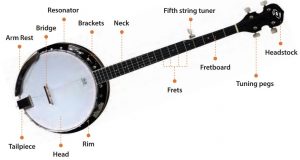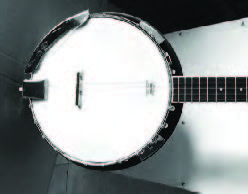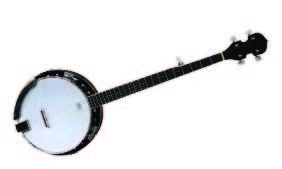
PYLE 5-String Banjo User Manual


5-String Banjo with White Pearl Color Plastic Tune Pegs & High-Density Man-made Wood Fretboard and Accessory Kit.
INTRODUCTION
Congratulations on your new Pyle 5-String Banjo! Your new banjo will bring you hours of enjoyment and musical expression. This manual was written to help you maintain your banjo in peak playing form. It isn’t difficult to maintain your banjo if you understand what needs to be done. That is our goal with this booklet, to help you keep the sound and playing comfort that you felt on the first day your banjo arrived! There are things you need to do after each playing and things that only need to be done every few months, depending on how often you play. HAVE FUN! Your musical journey has just begun!
FIVE STRING BANJO PARTS


HOW TO SET UP YOUR BANJO
A good set-up of your banjo is extremely important if you want to get the highest quality sound.Each Pyle USA 5-String Banjo is set-up to perfection before it is allowed to leave our shop. However, over time, different variables can aect the original set-up. It is good to check your new banjo after 5 or 6 months to see if it has changed. After that, it is good to check it regularly twice a year. The most common variables that change the banjo can include any temperature changes from extreme hot to cold, or how it is stored and how much it is played.
TUNE YOUR BANJO
Use the Digital Guitar Tuner to get exactly the right note.
Tune as follows:1st string D, 2nd string B, 3rd string G, 4th string D, 5th string GThen you must fine-tune the strings.
Fret each string as follows:They should each have exactly the same pitch as the 5th G string1st string on 5th fret, 2nd string on 8th fret, 3rd string on 12th fret, 4th string on 17th fret.


Hot tip:When you change strings, tighten each new string several times after the first tuning, pull it up from the fingerboard with your finger. This will help to stabilize tension on the tailpiece, bridge, nut and tuning peg and thus eliminate problems with tuning.
HOW TO TIGHTEN A BANJO HEAD




CHECK TAILPIECE POSITION


When the tension on the banjo head is correct, the base of the tailpiece should be about 2 – 3 mm (5⁄64″ to 1⁄8″) above the tension hoop.Check the adjusting screw to change the tension of the strings.Tighten this screw only to minimum tension, just enough not to be loose.After that, try the strings and the head to see if they have held their tuning again.
PUT THE BRIDGE ON AND TUNE THE BANJO
On most five-string banjos the bridge should be 12″-13″ from the twelfth fret. Figure out which end of the bridge needs to go under the skinny strings, put the bridge under the strings, and start tightening the strings until the bridge stays in place by itself.


Now measure the distance between the nut and the twelfth fret. The distance from the twelfth fret to the bridge should be about the same. Tune the banjo up to the tuning you plan to use (usually DGBDg for Bluegrass or DGBCg for folk, starting with the highest string first). You may use a digital guitar tuner if you’re not used to doing this by ear.
FINE TUNE THE BRIDGE PLACEMENT
Hold your left forefinger finger on the fourth (lowest pitched) string just over the twelfth fret without pushing it down onto the fret, and pluck the string with your right hand. You should hear the “octave” overtone, a bell-like sound one octave higher than the sound of the string unfretted. Now press the string down just behind the twelfth fret and pick it again. If the overtone is lower than the sound at the twelfth fret, move the bridge toward the tailpiece. Otherwise move it toward the neck.
Note:This skootching back and forth will untune your banjo, but it’s necessary. When you’ve got the bridge in the right place, you can retune.
Why does this work? When you make a string half as long as it was before it goes up an octave. In a perfect world, the distance from the 12th fret to the nut should be exactly the same as the difference between the 12th fret and the bridge. But when you push down on the string, you are stretching it just a little, so if the distances are exactly equal, the fretted string will be a tiny bit sharp. So you skootch the bridge toward the tailpiece a tad to compensate. Once they are the same, compare the octave overtone on the high D (rst) string to the sound of the same string fretted at the twelfth fret. This time you adjust by skootching just the end of the bridge. 90% of the time the bridge will not look “straight” when you’re done. In most cases, the part under the skinny strings will wind up closer to the neck than the part under the heavy strings. sometimes there’s quite an angle. This is normal, now retune the banjo.
BANJO CARE & MAINTENANCE
StoringIn general musical instruments like the same environment as their player, they need conditions where it is not too hot or hot and certainly not wet or damp! Keep your instrument clean and free from dust, dirt and moisture. Never leave it near a radiator or in a window where direct sunlight can fall upon the instrument and bake it. Never leave your banjo stored in a cold or damp place eg. cellar, loft or out in the garage!
CleaningEach time you have played your instrument give it a wipe over with a lint free cloth to remove nger marks. The strings can be cleaned with a string cleaning lubricant. From time to time you may want to polish your instrument, always check that this is suitable for the nish on your instrument. Always remove nger and body marks by using cleaning cloths. Never use abrasive cleaners as this can remove the plating.
FEATURES:
- Tunable 5-String Banjo, 24 Brackets
- Remo Milky Skin
- Sapele Plywood Resonator
- High-Density Man-made Wood Fingerboard
- Includes Allen Key and Wrench to Adjust Banjo Brackets
- White Pearl Color Plastic Tuner Key Pegs
- Features Additional 5th Geared Tuner Side-Peg
- Classic Traditional Style Binding Design
- Coated and Polished Rich Wood Finish
- Chrome-Plated Hardware & Accents
- Universal Adjustable Truss Rod
- Includes Maplewood Bridge Stand & Truss Rod Adjustment Tool
WHAT’S IN THE BOX:
- 5 string Banjo
- Travel / Storage Gig Bag, 5mm thickness
- (5) Spare Banjo Strings
- Detachable Shoulder Strap with hanger
- Banjo/guitar hanger
- Digital Tuner
- Cleaning Cloth
- (3) ABS fingers Picks
- Wrench (to adjust the banjo brackets)
DIGITAL GUITAR TUNER:
- Convenient Clip-on Design
- Tuning Range: A0 – C8 (27.5 – 4186 Hz)
- Response Time: <20ms
- Used for Stringed Instruments: Guitars, Bass, Violins, Ukuleles
- Battery Powered Tuner: Requires (1) x Button Cell (CR-2032), Included
- Tuner Size: 2.4’’ x 1.0’’ x 2.0’’ -inches
TECHNICAL SPECS:
- Total Guitar Length: 38.6” -inches
- Number of Picks: 3 pcs.
- Back and side material: Sapele plywood Resonator
- Banjo top: Remo Milky skin
- Fretboard/Fingerboard Material: High-Density Man-made Wood
- String Material: Steel
- Number of Frets: 22 Frets
- Total Guitar Dimensions (L x W x H): 38.6” x 13.2” x 4” -inches



Questions? Issues?We are here to help!Phone: (1) 718-535-1800Email:
References
[xyz-ips snippet=”download-snippet”]

